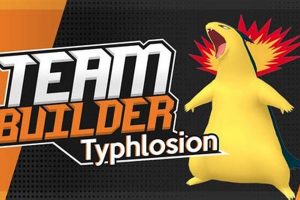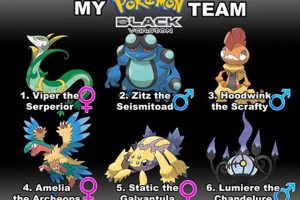A composition in the competitive environment of the Pokmon video game series, built around the strategic deployment of the Rain weather condition to enhance the capabilities of specific Pokmon. The application of moves such as Rain Dance or abilities like Drizzle activate this weather, which then provides benefits such as increased Water-type move power and decreased Fire-type move power. An example would be a team featuring Pokmon with the Swift Swim ability, which doubles their Speed stat in rain, capitalizing on the weather effect for offensive pressure.
The strategic value lies in its ability to quickly overwhelm opponents through increased offensive output and altered speed tiers. Historically, its prominence in competitive battling has fluctuated based on the availability of Pokmon with rain-synergistic abilities and the prevailing metagame. Success with such a team demands careful planning of team composition, prediction of opponent strategies, and precise execution during battles.
The following sections will delve deeper into the specific Pokmon commonly utilized, the strategic considerations involved in building and piloting this type of team, and the prevalent countermeasures employed by opponents.
Essential Considerations for Rain-Based Pokmon Teams
The following guidelines address critical aspects of constructing and utilizing a Rain team effectively within the competitive Pokmon environment. Mastery of these points will significantly enhance the team’s performance and overall strategic viability.
Tip 1: Prioritize Weather Control: Maintaining consistent rain is paramount. Include Pokmon with the Drizzle ability to establish rain immediately upon entering the battlefield. Alternatives include setting up rain with the Rain Dance move, but relying solely on this approach is less reliable due to limited turns.
Tip 2: Leverage Swift Swim: Swift Swim doubles a Pokmon’s Speed stat in rain, creating potent offensive threats. Examples include Barraskewda and Kingdra, which become incredibly fast and difficult to outspeed under rain conditions.
Tip 3: Exploit Thunder’s Accuracy: Thunder, a powerful Electric-type move, gains 100% accuracy in rain. Pairing this with a Pokmon like Zapdos or Raikou provides reliable damage output and coverage against Water-type Pokmon that resist Rain-boosted Water attacks.
Tip 4: Account for Fire-Type Weakness Mitigation: Rain halves the power of Fire-type moves. Select Pokmon that would otherwise be vulnerable to Fire-type attacks to benefit from this defensive advantage. For instance, Ferrothorn, a Grass/Steel type, becomes considerably more durable against Fire-type threats under rain.
Tip 5: Include a Defensive Pivot: A defensive Pokmon capable of switching into unfavorable matchups and providing support is crucial. Toxapex, for example, can absorb hits, spread status conditions, and provide valuable utility to maintain momentum.
Tip 6: Address Opposing Weather Teams: Teams relying on Sun, Sandstorm, or Hail can disrupt rain strategies. Include Pokmon or moves capable of countering these opposing weather conditions, such as a Pokmon with the ability Cloud Nine or moves like Defog.
Tip 7: Consider a Secondary Win Condition: Over-reliance on rain can become predictable. Implement a secondary strategy that can function independently of the rain condition to maintain flexibility and surprise the opponent. This might involve a bulky setup sweeper or a powerful wallbreaker.
Adhering to these principles enables a more resilient and effective Rain team, maximizing its potential for success in competitive Pokmon battles.
The subsequent sections will elaborate on team building specifics, common threats, and advanced strategic maneuvers associated with this competitive style.
1. Weather control
Weather control is a foundational element of any viable competitive Pokmon team. In the specific context of the “pokemon rain team”, establishing and maintaining the Rain weather condition is not merely advantageous, but often a necessity for strategic success.
- Initial Rain Setup
The primary method for establishing rain typically involves a Pokmon with the Drizzle ability. Politoed and Pelipper are common choices, immediately activating rain upon entering the battlefield. The advantage of Drizzle lies in its automatic effect, negating the need to expend a turn using the Rain Dance move and providing immediate benefits to the team.
- Rain Duration and Extension
Rain naturally lasts for five turns, or eight turns if the Pokmon holding the Damp Rock item enters the battle. Extending the rain’s duration is critical for maximizing the offensive pressure and defensive benefits offered by the weather condition. Strategic switching and item management are therefore essential for maintaining consistent rain support.
- Opposing Weather Disruption
The competitive environment often features opposing weather conditions such as Sun, Sandstorm, or Hail, each offering unique strategic advantages. Addressing these opposing weather effects is crucial for a rain team. This can be achieved through the use of Pokmon with the ability Cloud Nine, or by utilizing moves such as Defog or weather-changing attacks like Sunny Day or Sandstorm to overwrite the existing condition.
- Strategic Weather Reset
In scenarios where the opponent successfully overwrites the rain, or if the rain has expired, a contingency plan is necessary. This may involve having a secondary Pokmon with the Drizzle ability, or strategically utilizing the Rain Dance move to re-establish rain at a critical juncture. The ability to adapt to changing weather conditions is paramount for the long-term success of a rain team.
The capacity to effectively control the weather through initial setup, duration management, opposing weather disruption, and strategic resetting directly influences the overall effectiveness of the “pokemon rain team”. Consistent weather control is paramount for capitalizing on the speed and power boosts provided by rain, allowing the team to execute its core strategy and achieve victory in competitive battles.
2. Swift Swim Synergy
Swift Swim is an ability that doubles a Pokmon’s Speed stat when Rain weather is active, creating a direct and potent synergy with strategies predicated on the Rain condition. This connection is a cornerstone of the viability and offensive prowess of a “pokemon rain team”.
- Offensive Momentum
The primary role of Swift Swim is to grant a significant Speed advantage, allowing Pokmon to outspeed and strike first against opponents. This offensive momentum is crucial for quickly eliminating threats and maintaining control of the battle. Examples include Kingdra and Barraskewda, which become exceptionally fast and difficult to counter under Rain.
- Overcoming Speed Control
In the competitive environment, Speed control strategies, such as Trick Room or opposing Speed-boosting abilities, are prevalent. Swift Swim enables a Rain team to circumvent these strategies and maintain its offensive pressure. The doubled Speed effectively neutralizes many common Speed control tactics.
- Type Coverage Integration
The most effective Swift Swim users are typically paired with appropriate type coverage to maximize their offensive output. A Water-type Pokmon with Swift Swim, such as Swampert, can utilize moves like Earthquake to address Electric-type Pokmon that resist Water, creating a more well-rounded offensive profile under Rain.
- Strategic Team Building
Incorporating Swift Swim users necessitates careful consideration of team composition. Supporting elements, such as Pokmon with Drizzle or those that can provide redirection or status support, are crucial for enabling Swift Swim to function effectively. The entire team must be built around maximizing the opportunities for Swift Swim to create offensive pressure.
These components form a critical basis for effective “pokemon rain team” construction. The strategic investment in Swift Swim directly translates to increased offensive pressure, control over the battle’s pace, and the ability to overcome common competitive strategies. The careful integration of Swift Swim with other team elements is paramount for realizing the full potential of a team designed around the Rain condition.
3. Thunder Accuracy
The relationship between the move Thunder and a “pokemon rain team” is primarily defined by the increase in Thunder’s accuracy from 70% to 100% when the Rain weather condition is active. This enhancement significantly elevates Thunder’s reliability as a damaging move, transforming it from a situational choice to a consistently dependable attack. Electric-type moves are particularly useful in addressing Water-type Pokmon, which often resist the Water-type attacks commonly employed within the team composition. A concrete example would be the inclusion of a Pokmon like Zapdos, equipped with Thunder, to directly counter opposing Water-types such as Pelipper or Toxapex, both of which are frequently encountered on opposing teams and can otherwise stall or disrupt the offensive momentum of the team.
The practical implications of this guaranteed accuracy are multifaceted. It reduces the risk of missed attacks, crucial in high-stakes competitive battles where a single missed move can determine the outcome. Furthermore, the certainty of Thunder’s hit rate allows for more aggressive strategic play, encouraging players to predict and capitalize on opportunities without the hesitation caused by the inherent inaccuracy of the move under normal circumstances. Some competitive teams even forgo using standard Electric-type moves, like Thunderbolt, in favor of Thunder due to the increased damage output, trading reliability outside of rain for superior damage potential within it.
In summary, the heightened accuracy of Thunder under Rain weather conditions is a key component of the offensive strategy employed by “pokemon rain team”. It mitigates the inherent risk associated with the move, ensuring a reliable source of damage against crucial threats, and facilitates a more aggressive and predictable offensive playstyle. The understanding of this connection is therefore vital for effectively constructing and utilizing a competitive team centered on the strategic deployment of Rain.
4. Fire-type mitigation
The reduction of Fire-type move power under Rain weather conditions serves as a crucial defensive component for a “pokemon rain team”. Rain halves the damage inflicted by Fire-type attacks, transforming a potential weakness into a manageable threat, or even an advantage. This mitigation is especially important considering that many Water-type Pokmon, frequently employed in such teams, possess a vulnerability to Fire-type attacks. The strategic importance lies in enhancing the survivability of key offensive and defensive assets, allowing them to withstand attacks that would otherwise be debilitating.
Practical application of this effect is evident in team compositions including Pokmon such as Ferrothorn, a Grass/Steel type that is normally heavily threatened by Fire-type moves. Under Rain, Ferrothorn’s vulnerability is substantially lessened, enabling it to function more effectively as a defensive pivot and utility Pokmon. Another scenario involves Volcarona, a Fire/Bug type, whose powerful Fire-type attacks are severely hampered, making it less effective against the Rain team. The reduced Fire-type damage also creates opportunities for setup sweepers, allowing them to survive initial onslaughts and subsequently capitalize on stat boosts.
In summary, Fire-type mitigation represents a key defensive synergy within a “pokemon rain team.” The halving of Fire-type move power significantly enhances the survivability of Rain-dependent Pokmon and weakens opponents reliant on Fire-type offense. Strategic understanding of this dynamic enables the creation of more resilient and effective team compositions within the competitive environment.
5. Defensive pivot
A Defensive pivot within a “pokemon rain team” serves as a crucial component for maintaining strategic advantage and weathering unfavorable matchups. These Pokmon are selected for their defensive capabilities, typing, and access to support moves, allowing them to switch into attacks that would otherwise threaten the core offensive members of the team. The ability to absorb damage, spread status conditions, and provide strategic switching opportunities are all defining characteristics of a Defensive pivot’s role in this context. The presence of such a pivot mitigates the inherent risks associated with an aggressive, weather-dependent strategy and provides a crucial buffer against unforeseen circumstances.
Consider, for instance, the inclusion of Toxapex on a rain team. Its high Defense and Special Defense stats, combined with the Regenerator ability (restoring health upon switching out) and access to moves like Scald (potentially inflicting burns) and Haze (resetting stat boosts), make it an ideal defensive pivot. Toxapex can reliably switch into predicted Electric-type attacks aimed at Water-type sweepers or absorb hits from physical attackers, while simultaneously applying pressure through status conditions. Another example is Ferrothorn, which resists Electric and Grass, providing valuable coverage. The selection of the Defensive pivot depends greatly on the team’s specific composition and the anticipated threats within the metagame, requiring careful consideration during team-building.
In summary, a Defensive pivot functions as a strategic safeguard for the “pokemon rain team,” providing essential protection and utility. The implementation of such a component reduces vulnerabilities, maintains momentum, and increases the overall resilience of the team, thus ensuring its continued viability within the competitive landscape. The effective selection and utilization of a Defensive pivot are critical for maximizing the strategic potential and mitigating the inherent risks associated with weather-based offensive strategies.
6. Opposing weather disruption
Strategies employed to counteract weather-based team compositions, notably those reliant on Rain, are categorized as opposing weather disruption. The reliance of a “pokemon rain team” on the Rain weather condition renders it particularly susceptible to tactics designed to neutralize or overwrite this specific weather effect. The effectiveness of the team is intrinsically linked to the sustained presence of Rain; consequently, disruption of this condition can significantly diminish its offensive and defensive capabilities. Common methods of weather disruption include the deployment of Pokmon possessing abilities that summon alternative weather conditions, such as Sunny Day (Sun), Sandstorm, or Hail. A prevalent example involves Tyranitar, whose Sand Stream ability initiates a Sandstorm upon entry, thereby negating the Rain and reducing the effectiveness of Water-type attacks while simultaneously boosting the Special Defense of Rock-type Pokmon.
The implementation of opposing weather disruption introduces a strategic countermeasure to the Rain team’s intended function. This may force the Rain team to expend resources re-establishing Rain, leading to a loss of momentum and potentially creating openings for the opposing team to capitalize. Furthermore, certain abilities and moves can directly negate the effects of weather, such as Cloud Nine or Air Lock which suppress the effects of all weather conditions. Defog, while not directly changing the weather, removes entry hazards that a “pokemon rain team” may rely on to pressure opponents expecting to switch to counter the weather. The significance of understanding these disruptive elements stems from the necessity to anticipate and mitigate their impact through strategic team composition, move selection, and tactical decision-making during battles. This understanding necessitates including Pokmon capable of either resetting the rain condition or functioning effectively even in the absence of it.
In conclusion, opposing weather disruption represents a significant challenge to the operational effectiveness of the “pokemon rain team.” Anticipation, strategic counter-measures, and team diversification are essential for maintaining viability against teams deliberately designed to exploit this vulnerability. The ability to adapt to variable weather conditions and mitigate the impact of opposing weather effects determines the overall resilience and competitive success of a team built around Rain.
Frequently Asked Questions
The following questions address common inquiries and strategic considerations regarding effective team construction.
Question 1: What constitutes the essential core of a successful team?
A Drizzle user, such as Pelipper or Politoed, to establish rain, combined with at least one Swift Swim user capable of exploiting the doubled Speed stat. Prioritization should be given to ensuring type coverage, reliable damage output, and mitigation of opposing weather effects.
Question 2: What are the primary threats to a viable team and how should they be addressed?
Primary threats include opposing weather teams, stall strategies, and priority moves. Mitigation strategies involve including Pokmon with the ability to reset weather conditions, powerful wallbreakers capable of bypassing defensive setups, and priority users of one’s own to counter opposing priority attacks.
Question 3: What is the optimal balance between offensive and defensive Pokmon in a successful team?
A balanced approach is typically favored, with a minimum of two dedicated offensive threats, one or two defensive pivots capable of absorbing hits and spreading status, and a utility Pokmon capable of providing support through entry hazard removal or redirection. The exact ratio depends on the specific metagame and team strategy.
Question 4: Are there specific items that are considered essential for team members?
Damp Rock is considered essential for the Drizzle user to extend rain duration. Life Orb is often utilized to increase damage output on offensive Pokmon, while Leftovers or Black Sludge is common on defensive pivots for passive recovery. Choice Scarf can also be useful on a fast Swift Swim user to outspeed even faster threats when rain is not active.
Question 5: How is one to effectively manage the limited duration of rain in battle?
Strategic switching and prediction of opponent moves are crucial. Utilizing a Damp Rock to extend the duration and implementing a backup plan in the event that rain is overwritten are both key considerations.
Question 6: Should one consider building a team around a single Swift Swim user, or multiple?
Multiple Swift Swim users can increase offensive pressure and provide redundancy, but may render the team excessively vulnerable to weather disruption or common countermeasures. A single, well-supported Swift Swim user is often more reliable, allowing for greater strategic flexibility.
Mastery of these principles is key to successfully building and playing. Skillful implementation is required to maximize the team’s chances of success in competitive battles.
The following sections will delve deeper into advanced strategies.
Conclusion
This exploration has detailed the strategic nuances inherent in building and piloting a competitive “pokemon rain team.” Key elements, including weather control, Swift Swim synergy, and Fire-type mitigation, have been analyzed, emphasizing the importance of these aspects for maximizing offensive output and defensive resilience. Attention has also been given to the crucial role of defensive pivots, the need to counteract opposing weather conditions, and the necessity of adapting strategies to the evolving competitive landscape.
The effective application of these principles demands a thorough understanding of the game mechanics and a commitment to continuous refinement. The successful integration of the elements outlined herein serves as a foundation for competitive advancement, encouraging strategic innovation and adaptation in a dynamically shifting arena.







![Best Good Team for Pokmon Sun & Moon [Guide] Pokémon Guide & Updates – Latest News, Games, Cards, and Tips Best Good Team for Pokmon Sun & Moon [Guide] | Pokémon Guide & Updates – Latest News, Games, Cards, and Tips](https://pokepolitan.com/wp-content/uploads/2025/12/th-4338-300x200.jpg)